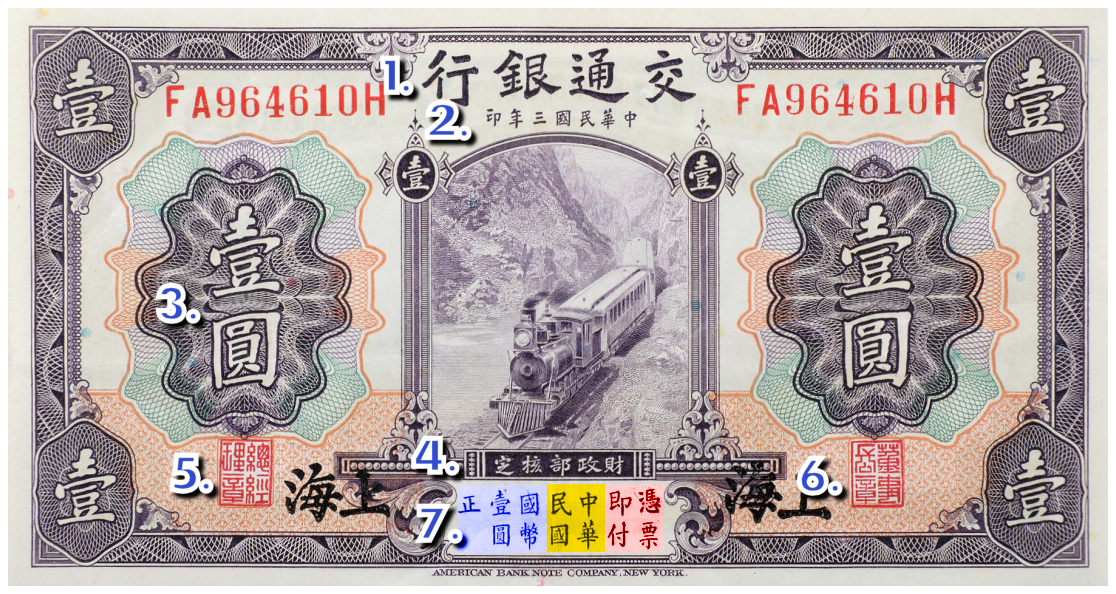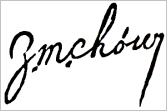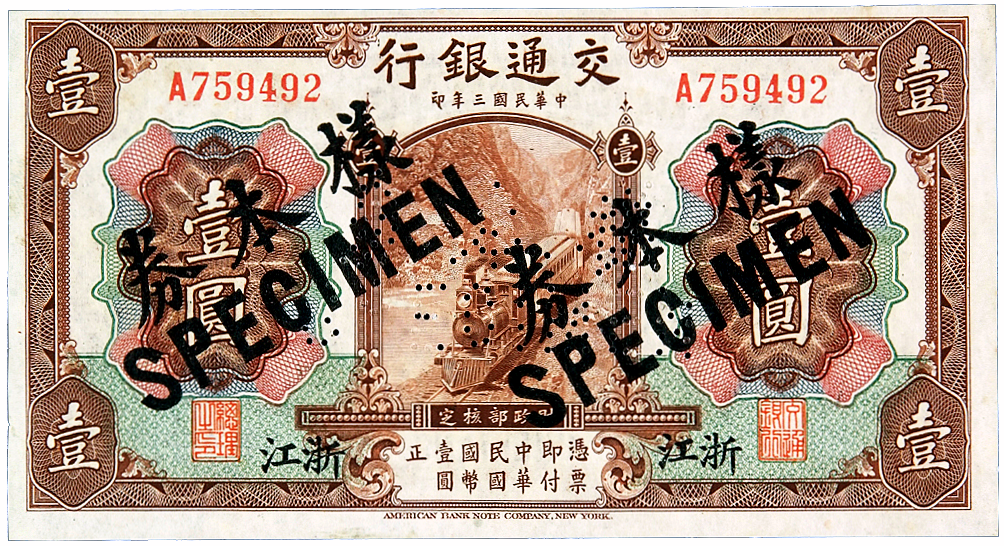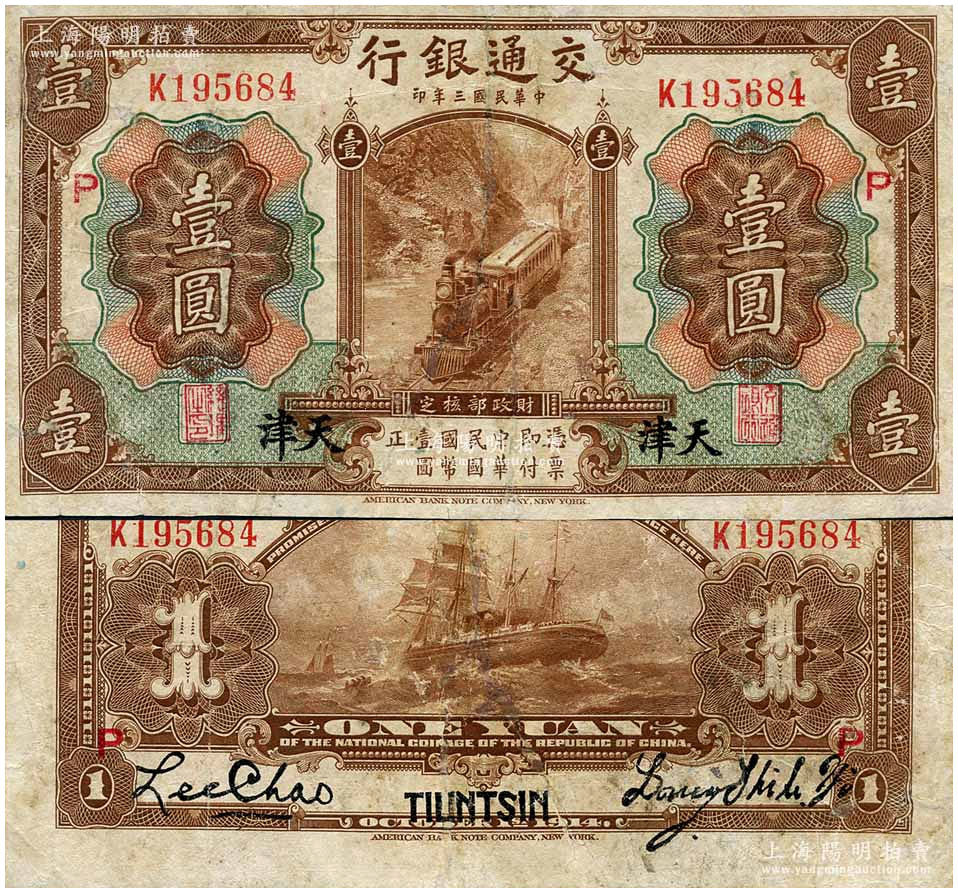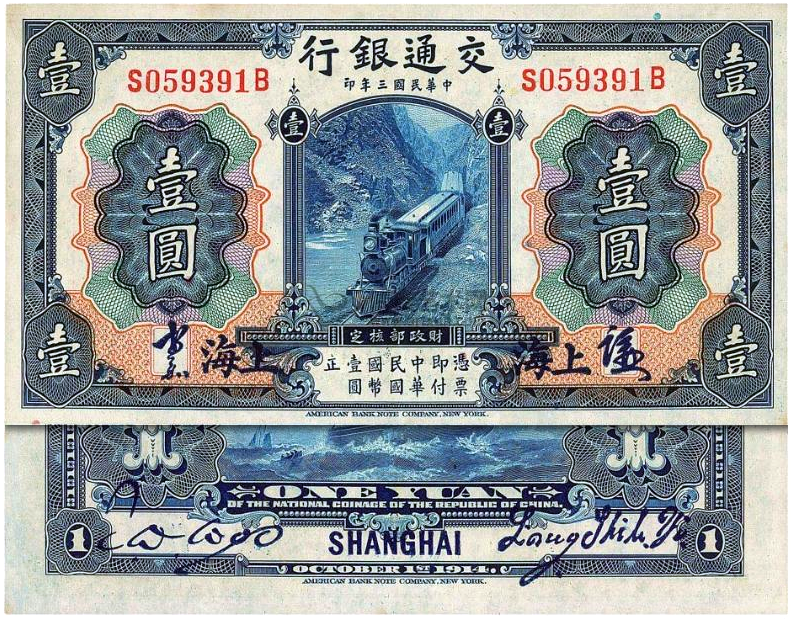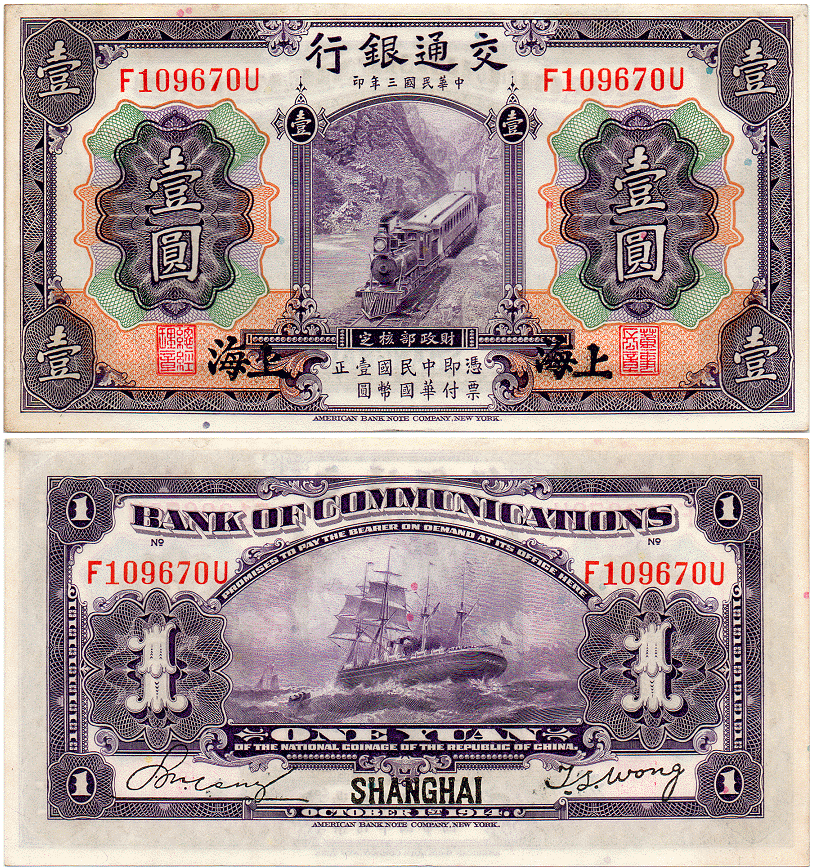|
(2018) July 07 2021
|
The Bank of Communications Series of 1914 - 交通銀行 三年
|
The Bank of Communications was founded at Peking (Beijing) during 1907-08 (the 34th year of the Guangxu reign period of the Qing Dynasty), by the Qing Board of Communications; a key figure was Liang Shih-i, a supporter of Yuan Shih-kai. A joint government and private-sector enterprise, it emerged as one of the first few major national and note-issuing banks in the early days of the Republic of China. Chartered as "the Bank for developing the country's industries", it took charge of the funds related to shipping, rail, telegraph and postal services. The bank became the governments "most important financial supplier". Its association with the clique of the would be emperor Yuan Shih-kai caused numerous political problems and at one point led to the suspension of currency issues by the bank. It is difficult to establish whether the first issues of the 1914 series were involved in this. It would explain the extreme scarcity of the earliest issues, however, later events during the Warlord era (1916-1927) may well be another factor. There was a 'run on the bank' in 1921.
In 1925-27 the controlling regional branch office was relocated from Peking to Tientsin (Tianjin) due to it's shift towards industry and away from politics. Indeed within a year the seat of government would be moved to Nanking (Nanjing), and Peking was additionally not felt to be a commercial centre either. No banknotes were issued by the downgraded Peking branch (in it's own name) after the early 1920s. Shanghai and Tientsin branch issues with secret markings were used instead. |
The headquarters moved to Shanghai in 1928. The bank was further reorganised in 1933, leading to a new General Manager (and Shanghai branch Manager), and later became a fully government controlled bank, from 1935.
In order to expand business into the overseas arena, the Bank opened its first Hong Kong Branch on 27 November 1934.
From September 1942, the Bank of Communications, along with the Bank of China, became an 'arm' of the Japanese puppet 'Central Reserve Bank of China' within all areas of Japanese control, and was by this point only circulating puppet currencies. The Bank within Nationalist controlled areas ceased to issue it's own money by the end of 1942, as currency issue was officially restricted to the Central Bank of China from then on. At least in theory.
After the Communist revolution of 1949, the bank was effectively split into two. The mainland operations became part of the Peoples Bank of China until re-emerging following restructuring in 1986. The section of the bank outside of the mainland continued until 1971 when it was privatized and merged with another bank to form the Mega International Commercial Bank.
In order to expand business into the overseas arena, the Bank opened its first Hong Kong Branch on 27 November 1934.
From September 1942, the Bank of Communications, along with the Bank of China, became an 'arm' of the Japanese puppet 'Central Reserve Bank of China' within all areas of Japanese control, and was by this point only circulating puppet currencies. The Bank within Nationalist controlled areas ceased to issue it's own money by the end of 1942, as currency issue was officially restricted to the Central Bank of China from then on. At least in theory.
After the Communist revolution of 1949, the bank was effectively split into two. The mainland operations became part of the Peoples Bank of China until re-emerging following restructuring in 1986. The section of the bank outside of the mainland continued until 1971 when it was privatized and merged with another bank to form the Mega International Commercial Bank.
|
The standard calligraphy of the Bank of Communications title, still used by the bank, is said to have been the work of politician Zheng Xiaoxu 郑孝胥 (1860-1938). Though highly regarded as a calligrapher, he is also however viewed as a traitor for involving himself with the Japanese and the puppet state of Manchukuo. He was the first Prime Minister of Manchukuo, for three years, however repeatedly clashed with the Japanese and was forced to resign, dying suddenly in 1938 from apparent poisoning. |
A few notes regarding specific branches:
The Chungking 重慶 (Chongqing) branch
This had seemingly either been closed or downgraded in 1917. The branch was re-established fully with the arrival of the Nationalist government in 1938. Chungking marked notes of course date from this 1938-1942 period.
The Hankow 漢口 (汉口) (Hankou) branch
A run on the Hankow branch of the Bank of Communications (and of the Bank of China) occurred in 1921. The details are proving difficult to find. Several examples of 1914 notes of this branch survive with the branch name altered to another more stable branch such as Shanghai.
The Sian 西安 (Xi'an) Branch
The development of the Longhai Railway led to the Sian (Xi'an) branch being established c.1934, which briefly became a note issuing branch. Its notes are among the scarcest of the 1914 series.
The 1914 Bank of Communications series of the American Banknote Company
|
The October 1st. 1914 series is of five denominations: $1, $5, $10, $50 and $100, all designed and printed by the American Banknote Company of New York. The later Shanghai branch issues - especially the $5 and $10 of this series are fairly common and familiar to collectors. However, it is an unusually complicated series when explored fully. It seems difficult to establish precisely when the 1914 series was introduced - dates on Chinese paper money are highly unreliable as an indicator of issue, and this series continued to be issued and circulated until c1940. There are numerous major and minor varieties of each denomination - especially of the $1, $5 and $10. |
Above right: All 1914 notes were originally conceived with the following text: "As prescribed in the law for national coinage promulgated by presidential order dated the seventh day of the second month of the third year of the Republic of China", as can be seen from this photographic printers proof.
|
The Chinese texts on the front of all denominations of the 1914 series (originally read from right to left)
1) 交通銀行: Bank of Communications 2) 中華民國三年印: The Third Year of the Republic of China (1914) 3) 壹 圆: One Yuan (One Dollar) 4) 財政部核定: Approved by the Ministry of Finance 5) 總經理章: Manager's Seal 6) 董事長章: Chairman's Seal 7) 憑票即付(read from right to left and top to bottom): Payable on Demand. 中華民國: Republic of China. 國幣圓壹正: 1 Yuan (or whichever denomination) in National Currency |
|
The colour change between notes of the same denomination is apparently in response to a wave of fraud/forgery which occurred in the latter half of the 1920s. The value of notes issued by different branches of the same bank were often not equal in value during this period. The names of problematic branches of issue were being removed and altered to that of a more secure and hence desirable branch. This meant that the notes had a greater value in exchange outside of the area of issue.
Right: an early 1 Yuan which shows that the original branch name (for Hankow) has been scraped off and replaced with Shanghai 上海 |
Notes bearing control numbers, Chinese character or letter overprints indicate that the place or branch of issue, or redemption, is other than the Bank of Communications branch name stamped on the note (more information here).
The vast majority of such notes are of the script signature type. Contrary to the statement in the Standard Catalog of World Paper Money, the 1914 series issues with Chinese script signatures on the front (in place of the red seals) are not the first issues of the 1914 series. Chinese sources state that this type was issued from 1927 and ceased before 1935 as they were no longer regarded as neccassary due to the currency reforms of that year.
Tientsin branch notes stamped with an 'H' are known to have been redeemable only at the Hankow (Hankou) branch. Notes stamped with a 'P' were only redeemable at the Peking (Beijing) branch.
The vast majority of such notes are of the script signature type. Contrary to the statement in the Standard Catalog of World Paper Money, the 1914 series issues with Chinese script signatures on the front (in place of the red seals) are not the first issues of the 1914 series. Chinese sources state that this type was issued from 1927 and ceased before 1935 as they were no longer regarded as neccassary due to the currency reforms of that year.
Tientsin branch notes stamped with an 'H' are known to have been redeemable only at the Hankow (Hankou) branch. Notes stamped with a 'P' were only redeemable at the Peking (Beijing) branch.
Signatures of bank officials on the 1914 series
|
1
Zhao Qinghua 赵庆华, Hankow (Hankou) branch manager |
2
Kiang ShihTeh (Jiang Shide) 江世德 Manager c1917 |
3
Xie Linying? 谢霖 (1885-1969) Manager c1917 |
4
Coa Rulin 曹汝霖 (1877-1966) General Manager from January 1917, resigned in 1921? |
5
Bao Peizhi 包培之 (Pao Kuang Yung) |
6
Chang Chien (Zhang Jian) 张謇 (1853-1926) - Governor 1922 - 1925 |
|
7
Chen Fuyi 陈福颐 (1881-?) |
8
Zhang Ying? Yang Yinsun (杨荫荪)? |
9
Sheng Zhushu 盛竹书 (1860-1927), Shanghai branch manager |
10
Unidentified signature only observed on one 1914 circulated 1 Yuan, and a 5 Yuan specimen, of the Anhui branch
|
11
Unidentified signature only observed on one 1914 1 Yuan of the Honan branch |
12
Unidentified signature only observed on one 1914 1 Yuan of the Honan branch |
|
13
Lei Chao 李钟楚 (Li Zhongchu) 鍣 Manager (Tsingtao, Tientsin) 1923 - 1933 |
14
Lu Xuepu 卢学溥 (1877-1956) Chairman 1928-1933 |
15
Hu Meng-chia (Hu Mengjia), T.D Woo, 胡孟嘉 (1888-1936) Assistant Manager Shanghai Branch 1922 - 1927, General Manager 1928 - 1933 |
16
Liang Shiyi/Shizhen 梁士诒 (1869-1933) General Manager 1918 - 1922 and 1925 - 1928 |
17
Tang Shoumin 唐寿民 General Manager 1933 - c1940 |
18
Wang Zisong 王子崧 Manager 1933 - 1942? |
|
13b
As above |
14b
As above |
15b
As above |
16b
As above |
17b
As above |
18b
As above |
|
19
Liang Rucheng 梁汝成, a signature found on a 5 Yuan of 1914 (branch unknown) |
The banknotes and their branch issue listings below: each denomination has been divided by color where possible, under which every known branch to have issued that type is listed. For each branch issue, the name of the branch as given on the note is placed first, followed by the modern name (if different), and then the name in traditional Chinese (as printed on the face of the note) followed by the name in modern Chinese. This is followed by the Standard Catalog of World Paper Money code (if there is one) and lastly the numbers indicating which signature pairings are known (to me).
1 yuan - 壹圆
One yuan of the National Coinage of the Republic of China. October 1st 1914.
Both vignette images on the 1 yuan were selected from a stock of multi-purpose engravings created by the ABNCo and not created specifically for these notes. The back image was probably engraved from a photograph or painting created in the United States, c1900. This ship vignette was (first?) used on currency created for Ecuador in 1903. The front image of the train is possibly based on a photo by US photographer William Henry Jackson.
(front) a train coming through a mountain pass. A differently angled view of what appears to be the same location in a photo by WH Jackson is thought to be a canyon in Mexico. Or Colorado. (back) a four masted steamship (mail ship?), of the c1890s.
|
There are three known colour varieties:
Brown (with red, green) (as example right) Some known with control overprints. Other branches and signatures, and signature combinations other than those listed below are likely. There is no signature information available at all for many branch issues. Some are only known as specimens. Standard Catalog of World Paper Money (SCWPM) codes are given - many are unlisted. They are almost always found in poor condition. Many examples have been altered during their circulating period to disguise their original branch of issue (for example, Hankow altered to Shanghai - sometimes only the Chinese name and not the English name is altered) Serials, red. Known prefix: A, B, C, D, E, F, G, H, J, K, L, M 3+4 signature notes were issued 1919-1921 Issued: c1915 to 1933 (at latest). Branches -/- signatures (numbers refer to signatures shown above) - /- known serial prefix/suffix Chefoo (Yantai) 煙台 (烟台) (SCWPM 116c) - 3+4 (p: -, A), 5+6 (p: J), 13+16 (p: M) Chekiang (Zhejiang) 浙江 (SCWPM 116d) - 3+4 (p: -, A, D) Hankow (Hankou) 漢口 (汉口) (SCWPM 116f) - 1+4, 7+4 (p: E,F), 3+4 (p: A, B, C, D), 1+6 (p: J), 1+16* (p: K). Some Hankow notes are marked with red control letters including D, H, T, Y (for example, 4 'D's on the front, and four on the back, please scroll down for an example). Also marked with red control characters (so far observed as a matching pair on the front only). Problems at this branch resulted in its notes often being found altered (usually only the Chinese name) to that of a more stable branch, such as Shanghai Honan (Henan) 河南 (SCWPM 116g) - 3+4 (p: A, E), 7+4 (p: F), 11+12 (p: B) Kalgan (Zhangjiakou) 張家口 (张家口) (SCWPM 116h) - 3+4 (p: A) Kiangsu (Jiangsu) 江蘇 (江苏) (SCWPM 116i) - 3+4 (p: -), (p: D). Some Kiangsu issues have Chinese character control marks in matching pairs Kiukiang (Jiujiang) 九江 (SCWPM 116k) - 7+4 (p: F), (p: J). Only observed example has had the Chinese branch name on the front altered to that of Kiangsu, indicating some form of instability at the Kiukiang branch during this period. This is more commonly observed with Hankow branch notes. Kweihua (Kweisui, Hohhot) 歸化 - 3+4 (p: A) Lungkow (Longkou) 龍口 (龙口) - Pukow (Pukou) 浦口 (SCWPM 116l) - (p: D), 7+4 (p: F) Shanghai 上海 (SCWPM 116n) - 3+4 (p: -,A,E), 9+6 (p: H), 9+16 (p: K) Shantung (Shandong) 山東 (山东) (SCWPM 116p?) - 3+4 (p: A), 5+6 (p: J) Tsingtao (Qingdao) 青島 (青岛) (SCWPM 116s) - 5+6 (p: A,H), 13+14* (p: L), 5+16 (p: K), * 13+16* (p: L), - (p: J) Changhchun 長春 (长春) (SCWPM 116b) - Wusih, Kiangsu (Wuxi, Jiangsu) 無錫 (无锡) - 3+4 (p: A) Peking (Beijing) 北京 - 7+4 (p: A, G) Nanking (Nanjing) 南京 - 3+4 (p: A), 7+4 (p: F) Yangchow (Yangzhou) 揚州 (扬州) - Anhwei (Anhui) 安徽 - 10 (p: B) Mukden, (Fengtien, Shenyang) 奉天 Tulunnoerh (Dolon Nor) 多倫 (多伦) (SCWPM 116u) - 3+4 (p: A) Tientsin (Tianjin) 天津 (SCWPM 116r2) - 3+4 (p: E), 5+6 (p: K), - (p: H), - (p: M) example known with possibly official 'WA' control mark Tientsin (Tianjin) 天津 (SCWPM 116...) with 'H' control letter (Hankow) stamped twice on each lower side, with red cross beside serials - 3+4 (p: C) Tientsin (Tianjin) 天津 (SCWPM 116...) with 'P' control letter (Peking), example shown upper right - 13+16 (p: K), - (p: M) Gui Hua? (Hohhot?) 歸化 , Inner Mongolia - Paotow (Baotou) 包頭 (包头) - Shihkiachwang (Shijiazhuang) 石家莊 (石家庄) - Ningpo (Ningbo) 寧波 (宁波) - * With seals Right: Hankow branch issue with signatures 1+6. As mentioned above, this note is an example of those marked with red control letters, in this case 'D', four times on each side. In addition, this example also has a red pair of letters/characters(?) on the front only, at the left and right. The scheme behind these control markings is not known and is not related to that commonly found on later 5 and 10 yuan 1914 note types with script signatures on the front in place of the usual red seals. Blue: (as right)
Issued: c1927-1933 Branches: Kiukiang (Jiujiang) 九江 (SCWPM 116a) - 15b+16b+15+16 (p: S, s: B) Shanghai 上海 (SCWPM 116o) - 15b+16b+15+16, (p: S, s: A, B) (as image, right). Crude but rare period forgeries are known Shantung (reported, but no evidence found) Purple: (as right)
Issued: 1933 to c1940. Specimens without branch name are known marked C.P.R. and archive-stamped July 9 1937 by the ABNco. Branches: Chungking (Chongqing) 重慶. Issued from 1938 to before 1942 (SCWPM 116e) - 17+18 (p: F, s: Y), (p: F+A, s: A,C,D) Shanghai 上海 (SCWPM 116m) - 17+18 (p: F, s: B,C,D,E,F,G,H,J,K,L,M,N,P,R,T,U,V,W,X,Y) (p: F+A, s: D,E,F,G,H,J) Shanghai 上海 with 'P' control letter (Peking) (SCWPM 116t) - 17+18 (p: F, s: P) Tientsin (Tianjin) 天津 (SCWPM 116r1) - 17+18 (p: F, s: D,E,F) (p: F+A, s: B,D) Amoy (Xiamen) 廈門 (SCWPM 116a) doubtful?- Foochow (Fuzhou) 福州 on Amoy (Xiamen) 廈門 (SCWPM 116w)- 17+18 (p: F, s: A) Sian (Xi'an) 西安 (SCWPM 116q) - 17+18 (p: F, s: A) |
Above: Chekiang branch specimen
Above: A 10 Sucres of Ecuador (El Banco Comercial Y Agricola), issued 1903-1925. Printed by the American Banknote Company, this ship vignette was reused on the Bank of Communications 1 Yuan of 1914.
Above: Tientsin branch issue with 'P' control marks for actual issue/redemption at Peking (Beijing). The note has been repaired which explains the apparent but unoriginal misspelling of Tientsin.
|




